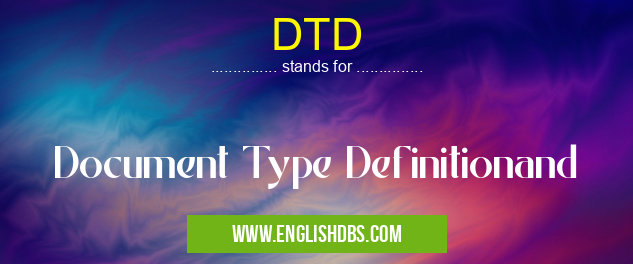What does DTD mean in UNCLASSIFIED
DTD stands for Document Type Definition. It is a set of rules that define the structure and elements of an XML document. DTDs are used to validate XML documents and ensure that they conform to the defined structure.

DTD meaning in Unclassified in Miscellaneous
DTD mostly used in an acronym Unclassified in Category Miscellaneous that means Document Type Definitionand
Shorthand: DTD,
Full Form: Document Type Definitionand
For more information of "Document Type Definitionand", see the section below.
DTD Structure
A DTD consists of the following elements:
- Document Type Declaration: Specifies the root element of the XML document and the DTD that applies to it.
- Element Declarations: Define the elements that can appear in the XML document and their attributes.
- Attribute Declarations: Define the attributes that can be used with each element.
- Entity Declarations: Define special characters or entities that can be used in the XML document.
Benefits of Using DTDs
- Validation: DTDs allow you to validate XML documents against a defined structure, ensuring their correctness and consistency.
- Structural Definition: DTDs clearly define the structure of an XML document, making it easier to understand and navigate.
- Error Detection: DTDs help detect errors in XML documents during validation, preventing invalid data from being processed.
- Interoperability: DTDs facilitate interoperability between different XML applications by providing a common understanding of the document structure.
Essential Questions and Answers on Document Type Definitionand in "MISCELLANEOUS»UNFILED"
What is a Document Type Definition (DTD)?
A DTD is a set of rules that define the structure and elements of an XML document. It ensures that XML documents conform to a specific structure, making them easier to validate and process.
What is the purpose of using a DTD?
A DTD serves several purposes:
- Ensures data consistency and validation
- Defines the structure and content of XML documents
- Facilitates interoperability between different XML processors
- Enhances code readability and maintainability
- Helps detect errors during parsing and validation
How do I create a DTD?
To create a DTD, you can use the following steps:
- Define the root element and its structure
- Specify the attributes and their data types
- Describe the relationships between elements
- Use keywords like "ELEMENT" and "ATTLIST" to declare elements and attributes
- Save the DTD file with a .dtd extension
What is the difference between a DTD and an XML Schema?
While both DTDs and XML Schemas provide validation for XML documents, they differ in several ways:
- Syntax: DTDs use a simpler syntax based on SGML, while XML Schemas use a more complex syntax based on XML itself
- Extensibility: DTDs are less extensible than XML Schemas, which support namespaces and inheritance
- Data types: DTDs support a limited set of data types, while XML Schemas provide a richer set of data types and constraints
- Validation: DTDs validate documents based on their structure, while XML Schemas validate documents based on their structure and content
Final Words: DTDs play a crucial role in ensuring the validity and consistency of XML documents. By defining the structure and elements of an XML document, DTDs help in error detection, structural definition, and interoperability. They are a valuable tool for organizations that need to exchange and process XML data effectively.
DTD also stands for: |
|
| All stands for DTD |
